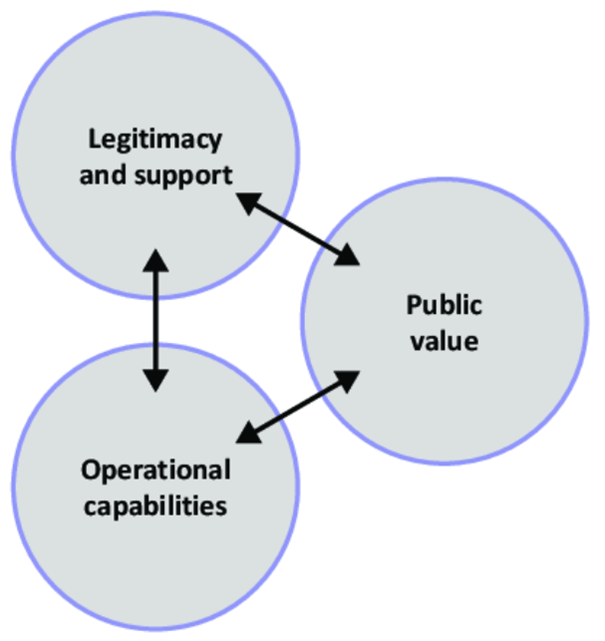Image: Copilot
Introduction
I wrote this story about 10 years ago after completing Michelle Bowden's presenting course. I used her blueprint for persuasive presentations to write a persuasive story on public value. In particular, I wrote about the strategic triangle and managing street trees. It continues the discussion about value started in my previous story.
Since writing this story, I have heard Professor Mark Moore talking about the strategic triangle. He says it is essential to have all three corners of the triangle. A public manager with only one or two corners of the triangle in place is bound to fail. How often do you see public policy authorising action on a matter of agreed public value but the organisation doesn't have the capability to implement it? Or there might be something well within the capability of the organisation to do, and the community is calling out to have done, but the elected representatives won't approve it?
The strategic triangle takes my story about Nested Value Boxes a step further by providing a structured approach to closing the gaps between boxes. The elected representatives in the authorising environment must close Gaps 2 and 3, and the appointed administration, by improving organisational capability, closes Gap 1. I agree with Moore when he says they are all ‘public managers’ and must work together effectively if public value is to be created.
The story uses the term ‘customer’ for people requesting a service. It could just as easily be citizen or whatever term you prefer to describe a person from the community requesting the council to do something. I am aware of the concerns many people hold that the use of customer ignores people’s rights as citizens and turns all interactions with the council into a transaction. That is not the intention.
The case study in the story really happened.
The Story: Put the strategic triangle into practice and improve your street tree management
“If you do build a great experience, customers tell each other about that. Word of mouth is very powerful.”
Jeff Bezos, CEO Amazon.com
This is no doubt true. We have all told others about our good experiences. Unfortunately, many of the stories told about the public service are based on poor rather than great experiences. Further, these poor experiences tend to create the brand or image of our organisation in the community we serve.
Public services are often the source of misunderstanding or complaint. Customer requests can indicate how well services are meeting needs or expectations. The reality for many public services is that they have not been designed to provide a great customer experience. You can provide great customer experiences and reduce service requests by using the strategic triangle approach.
This case study shows how using the strategic triangle can reduce customer requests, contain costs, and fulfil expectations to provide customer experiences and value. I know that many landscape managers find customer requests are unpredictable and difficult to control. Using the strategic triangle approach can reduce requests and the requests that are made will be better anticipated because fail points in operations are managed. This case study examines street tree management in local government.
Levels of customer requests can indicate how we are performing. Sometimes they are part of a maintenance strategy, for example ‘operate to failure’, and they are the way you find out about something that needs to be done. Often though, requests indicate you are not providing a service the way the public think you should. Frequent requests for the same service or for services at the same location and the escalation of requests are indicators of a mismatch between manager and customer understanding and expectations. Reducing customer requests will reduce inconvenience because people will not have to make the effort to contact you. They will be pleasantly surprised.
The strategic triangle
The strategic triangle was described by Professor Mark Moore in 1995. It identifies three ‘environments’ in which public service managers operate – the authorising environment, the public value environment and the operating capability environment.
The strategic triangle
Moore says that managers in the public sector need to answer the following questions before committing to a course of action:
What is the public value that you are producing from the action?
What sources of legitimacy and support create the authorising environment for that action?
What operational capabilities does your organisation need to have or develop to carry out that action to produce the required value?
The public value environment deals with the ‘across the counter’ interaction with service users or customers and whether their expectation of value is met.
The authorising environment determines what revenues can be raised and what they can be used for on behalf of the community to provide services.
The operating capability environment deals with the organisation’s ability to deliver services agreed collectively or sought individually.
Often there are conflicts when the expectation of individual value does not align with the collective value that has been agreed to be provided. This manifests itself in requests for standard services to be customised. Attempts to customise or tailor services often result in service failure when operations have not been designed for that purpose.
Under these circumstances, managers should return to the authorising environment to obtain changes to policy, service levels or resourcing. Skills are required to operate in the political (authorising) environment, understand customer service (public value) and know how to design operations (operating capability).
The Case Study
This is a real-life story that explains how to understand and act on customer service requests to reduce them over time using the strategic triangle approach.
In 2004 customer service requests related to street trees at a Melbourne council had been running at around 3500 per annum for several years. This is typical for the size of local government area and was around one service request for every 25 trees in the total tree population and the landscape manager decided to see if the number of requests could be reduced. The approach taken was to understand demands driving the requests, review operations and redesign services to reduce the need for residents to contact Council to request a service. It was successful. Over a 5 year period service requests reduced from 3500 to 600 per annum – a 580% reduction.
Step 1 - Review demands
The first step was to review the categories of requests being recorded to make sure that they provided useful information to understand the purpose of the resident making the request. What did the requester want to have done? The requests included categories for different types of services as well as repeat requests or complaints when services requested had not been delivered or delivery did not meet expectations. Some categories were redefined and new data was collected. Most data used was collected over a 5 year period. A project team of staff involved in various aspects of tree management led the change process.
Step 2 – Fix the system
This data provided a focus for service improvements:
New scripts were written for customer service officers and posted on the internet. This was preferred to the intranet because it also made them available to the community to help set/manage expectations of services. The scripts covered who would respond to the request, how long it would take and how the requestor would be kept informed.
Policies were reviewed for tree management and asset management. They had been adopted by the Council and set the key parameters for tree management. The biggest change was to discontinue managing trees using an ‘operate to failure’ approach and to commence staged replacement of trees. The cost of creating an uneven aged and sustainable tree population was modelled. The Council was informed of the potential for biological collapse of the aging street tree population if renewal didn’t begin immediately.
Capital funding was obtained to implement the asset management plan and approximately 5% of the tree population was targeted for removal based on condition assessment, incident reports and customer service requests. This removed the ‘big ugly’ trees, which were generating disproportionate numbers of requests, with the support of the community.
Operational reviews were conducted to examine response times promised and delivered, how requests were prioritised and resources allocated, and how customers were kept informed. Some services were redesigned to achieve required timelines. For example, stump removal was identified as a problem because stumps were being missed, inadequate grinding was resulting in suckering, and payment claims could not be readily verified. The process to measure and list stumps when trees were removed, to provide those lists to contractors and to supervise contractor performance were updated.
Service failures were identified and analysed to determine whether service systems, Council staff or contractors were affecting performance.
Contracts for services were reviewed and rewritten to bring the inspecting/work planning role in-house, improve accountability for delivery of elements of the service, and control the use of sub-contractors
Service levels were changed for some key aspects of services and this was recorded in the advice to CSO’s and in contract specifications.
Step 3 – Engage the community
Public meetings were organised and community/opinion leaders were invited to discuss tree services. Keynote speakers led discussion on tree management issues. Valuable feedback was received regarding tree services.
Step 4 – Monitor performance
At the conclusion of the change process service requests were continuously monitored and fine tuning of the changes was ongoing. The service delivery operation was now understood. Service requests could be anticipated at key points where service failure was most likely to occur.
How does this relate to the strategic triangle?
Well, the starting point was in the ‘public value’ environment to understand why customers were finding the need to contact the Council. For example, repeated requests for the same service when re-work was necessary or escalations when staff said that services could not be tailored to suit individual demands. This is the daily work of many managers.
Then, the ‘authorising environment’ for the tree services had to be adjusted. The political reluctance to remove over-mature trees because of community attachment to the trees had led to a policy position that was the equivalent of replacing buildings once they start to fall down. The change was to view trees as assets with a defined life span. This provided permission to remove the high risk and problematic trees that were driving many customer service requests.
Finally, the ‘operating capability’ was changed by redesigning tree management operations to ensure that services deliver the required value.
The residual request rate of one request per 150 trees is manageable and will contain long term costs.
In summary, customer service requests can indicate how well services are meeting community needs or expectations. Reducing service requests will reduce inconvenience and the need for people to make the effort to contact you. The strategic triangle identifies three ‘environments’ in which public service managers operate – the authorising environment, the public value environment and the operating capability environment.
The case study shows that using the strategic triangle approach can be effective in reducing customer service requests. Over a 5-year period service requests reduced from 3500 to 600 per annum. Use the strategic triangle approach to improve your performance.
If you don’t use the strategic triangle approach it will be difficult to connect the various ‘environments’ in which you operate to effectively improve customer value. When you do use the strategic triangle, those relationships became clear and decisions can be made in the right places to enable the service improvements necessary to reduce customer requests.
This is an exciting opportunity to review how you deliver customer value and to provide your customers with a great experience for their next story!
Footnote
For those who are unfamiliar with Michelle Bowden's blueprint for persuasion, it is explained well on her website.





